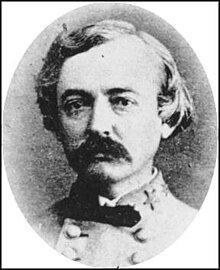William H.C. Whiting
|
Major General William H.C. Whiting |
|
|---|---|
 |
|
| Nickname(s) | Little Billy |
| Born |
March 22, 1824 Biloxi, Mississippi |
| Died | March 10, 1865 (aged 40) New York City |
| Buried at | Oakdale Cemetery in Wilmington, North Carolina |
| Allegiance |
|
| Service/branch |
|
| Years of service | 1845–61 (USA) 1861–65 (CSA) |
| Rank |
|
| Battles/wars | American Civil War |
| Spouse(s) | Katherine Davis |
William Henry Chase Whiting (March 22, 1824 – March 10, 1865) was a United States Army officer who resigned after 16 years of service in the Army Corps of Engineers to serve in the Confederate States Army during the American Civil War. He was wounded at the Second Battle of Fort Fisher by a musket ball to his leg, and died in prison camp on March 10, 1865 of dysentery.
William Whiting was born on March 22, 1824, in the coastal community of Biloxi in southern Mississippi. At the age of twelve, he was an outstanding student and graduate of English High School of Boston in Boston, Massachusetts. At sixteen, he graduated from Georgetown College (now University) in Washington, D.C.. The son of Lieutenant Colonel Levi Whiting, a respected officer in the 1st Artillery Regiment, and Mary A. Whiting, he continued to impress his instructors at the United States Military Academy at West Point, New York, from which he graduated first in the class of 1845.
Appointed Second Lieutenant of Engineers, Whiting was involved in constructing seacoast defenses in Maryland and Florida and surveying military routes and frontier forts in west Texas. Whiting served at Fort Davis, Texas. He was the first to survey the Big Bend area for the U.S. Army. Promoted to First Lieutenant in 1853, Whiting was sent west, erecting harbor fortifications in San Francisco, California, and serving on the board of engineers for Pacific coast defenses until 1856. Lt. Whiting spent the five years before the Civil War improving rivers, canals, and harbors in North Carolina, South Carolina, Georgia, and Florida. He was promoted to Captain in the Corps of Engineers in 1858.
...
Wikipedia
